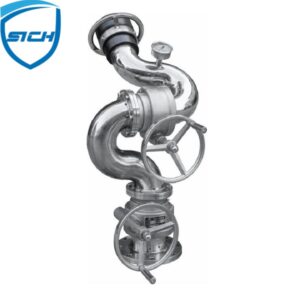Introduction:
In the realm of fire safety and prevention, fire water monitors play a crucial role in protecting lives, property, and the environment. These specialized devices are designed to deliver a high volume of water or firefighting foam over long distances, providing an effective means of combating fires, especially in hazardous or hard-to-reach areas. This article explores the concept of fire water monitors, their types, and their diverse applications in firefighting.
Understanding Fire Water Monitors:
A fire water monitor, also known as a water cannon or fire monitor, is a high-capacity nozzle that is typically mounted on a fixed or mobile platform, such as a fire truck, ship, or industrial facility. Its primary purpose is to deliver a concentrated stream of water or foam to extinguish fires or control hazardous situations.
Types of Fire Water Monitors:
1. Manual Monitors:
Manual fire water monitors are handheld devices that provide firefighters with flexibility and mobility during firefighting operations. They are typically lightweight and portable, allowing firefighters to direct water or foam precisely at the source of the fire. Manual monitors are often employed in scenarios where access is limited, or where fixed monitors are not available.
2. Portable Monitors:
Portable fire water monitors are larger than manual monitors but still retain a level of mobility. They are usually equipped with a base and wheels, making them easy to transport to different locations. Portable monitors are commonly used in industrial settings, oil refineries, chemical plants, and other areas where the risk of fires is high, and access to fixed firefighting systems may be limited.
3. Fixed Monitors:
Fixed fire water monitors are permanently installed in strategic locations, such as industrial facilities, airports, storage tanks, or marine vessels. They are designed to provide continuous and automated fire protection. Fixed monitors can be controlled manually, or remotely, allowing operators to aim the water or foam at specific targets. These monitors often have a high flow rate and can deliver large volumes of extinguishing agents over considerable distances.
4. Oscillating Monitors:
Oscillating fire water monitors are fixed monitors that can move horizontally and vertically to cover a larger area. They are equipped with a motorized mechanism that allows the monitor to sweep back and forth or up and down, enabling a broader coverage of the fire. Oscillating monitors are commonly used in situations where a wide area needs to be protected, such as storage yards, helipads, or open-air facilities.
Applications of Fire Water Monitors:
Fire water monitors find applications across a range of industries and scenarios:
1. Industrial Facilities:
Fire water monitors are indispensable in industrial settings where the risk of fires is prevalent. They can protect large storage tanks, process equipment, and production areas from fire hazards, providing an effective response in case of an emergency.
2. Marine and Offshore:
On ships, offshore platforms, and port facilities, fire water monitors are vital for fire protection. They are used to combat fires in engine rooms, cargo holds, and other critical areas where conventional firefighting methods may be challenging to employ.
3. Aircraft Rescue and Firefighting (ARFF):
Airports utilize fire water monitors for rapid intervention in the event of an aircraft fire. ARFF vehicles equipped with high-capacity monitors can deliver foam or water to suppress fires and facilitate the safe evacuation of passengers and crew.
4. Hazardous Materials:
Fire water monitors are essential for managing fires involving hazardous materials. Their ability to project water or foam from a safe distance ensures the well-being of responders while effectively controlling the fire and minimizing the risk of further contamination.
Conclusion:
Fire water monitors serve as a vital tool in the arsenal of firefighters and emergency responders. The different types of fire water monitors, including manual, portable, fixed, and oscillating monitors, offer diverse capabilities and flexibility in firefighting operations. Whether it’s combating fires in industrial facilities, protecting marine vessels, responding to aircraft emergencies, or managing hazardous material incidents, fire water monitors provide an effective means of delivering extinguishing agents with precision and efficiency.
The continuous advancement of fire water monitor technology, including improved flow rates, better control mechanisms, and enhanced maneuverability, ensures their effectiveness in tackling fires across various environments. As the field of fire safety evolves, so do the capabilities of fire water monitors, making them an indispensable tool for firefighting professionals worldwide.

